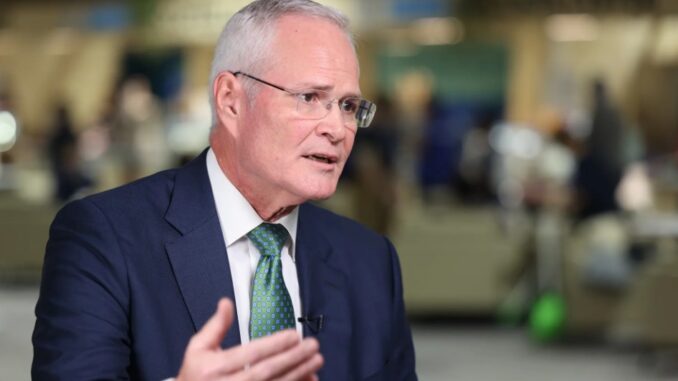
In a bold move signaling the oil giant’s pivot toward the electric vehicle (EV) ecosystem, Exxon Mobil Corp. CEO Darren Woods revealed a groundbreaking invention: a new form of synthetic graphite designed to supercharge EV battery performance. Speaking at the University of Texas at Austin’s Energy Symposium on September 12, Woods declared, “We’ve invented a new carbon molecule that will extend the life of the battery by 30%,” describing it as a “revolutionary step change in battery performance.”
This development not only promises to extend battery lifespan but also hints at improved range and faster charging capabilities, potentially reshaping the competitive landscape for EVs.Exxon’s innovation centers on a proprietary synthetic graphite material, which serves as a key component in lithium-ion battery anodes. Traditional graphite, often mined and processed overseas, has limitations in terms of durability and efficiency. Exxon’s version addresses these by enhancing the structural integrity of the anode, reducing degradation over time, and allowing batteries to maintain capacity longer.
Are you Paying High Taxes in New Jersey, New York, or California?
While exact details on range extension remain under wraps, industry experts suggest that a 30% boost in battery life could translate to meaningful increases in driving distance per charge, especially as EVs push toward 500+ mile ranges. Exxon plans to begin commercial production of this synthetic graphite by 2029, following its recent acquisition of key assets and technology from Chicago-based Superior Graphite Co., which bolsters its entry into the battery materials market.
This announcement comes amid Exxon’s broader strategy to diversify beyond fossil fuels, investing in low-carbon technologies while capitalizing on the booming demand for EV components. With global EV sales projected to surpass 20 million units annually by 2030, such innovations could position Exxon as a pivotal player in the supply chain.
But what does this mean for investors, the environment, and U.S. EV manufacturers? Let’s break it down.
Implications for Investors
For shareholders in Exxon Mobil (NYSE: XOM), this graphite breakthrough represents a high-stakes bet on the energy transition. Historically reliant on oil and gas, Exxon has faced pressure from activist investors and shifting market dynamics to embrace electrification. The synthetic graphite venture could unlock new revenue streams, with the global battery materials market expected to reach $50 billion by 2030. Exxon’s acquisition of Superior Graphite assets, announced just days before Woods’ speech, underscores its commitment, potentially adding billions in value if scaled successfully.
However, risks abound. Commercialization by 2029 means investors must wait years for tangible returns, and competition from established players like Albemarle and SQM in the lithium space could erode margins. That said, Exxon’s integrated approach—leveraging its chemical expertise and vast R&D budget—might yield superior yields. Post-announcement, XOM shares saw a modest uptick of about 1.2% in early trading, reflecting cautious optimism. Long-term, this could hedge against declining oil demand, appealing to ESG-focused funds and diversifying portfolios in a volatile energy sector.
Environmental Benefits and Challenges
From an environmental standpoint, Exxon’s synthetic graphite offers a greener alternative to conventional mining. Graphite extraction, predominantly in China, has been criticized for its high water usage, deforestation, and carbon emissions—issues that contribute to the very climate crisis EVs aim to combat. By producing graphite synthetically through Exxon’s chemical processes, the technology could slash these impacts, reducing the need for resource-intensive mining and shortening supply chains.
A 30% extension in battery life means fewer replacements over an EV’s lifespan, curbing e-waste and the environmental toll of battery production, which relies on rare earths and generates significant CO2. If widely adopted, this could amplify the net-zero benefits of EVs, potentially cutting lifecycle emissions by 10-15% per vehicle. Exxon, often vilified for its fossil fuel legacy, could burnish its green credentials here, aligning with global sustainability goals like the Paris Agreement.
Yet, skeptics point to Exxon’s core business: oil production still dominates its portfolio, and scaling synthetic graphite will require energy inputs that, if fossil-based, could offset gains. Transparency on production emissions will be key to validating these eco-claims.
Boost for U.S. EV Manufacturers
U.S. EV makers like Tesla, Rivian, and General Motors stand to gain immensely from a domestic graphite source. Currently, over 90% of battery-grade graphite comes from China, creating vulnerabilities in supply chains amid geopolitical tensions and tariffs. Exxon’s innovation could onshore production, enhancing energy security and reducing costs for American automakers.
For instance, Tesla’s Gigafactories and GM’s Ultium battery plants could integrate this graphite to achieve longer-lasting packs, directly addressing consumer pain points like range anxiety and battery replacement costs. A 30% life extension might lower ownership expenses by $2,000-$3,000 per vehicle, making U.S.-made EVs more price-competitive against imports. This aligns with the Inflation Reduction Act’s incentives for domestic sourcing, potentially unlocking billions in subsidies.
Moreover, faster charging with less degradation—implied by the tech’s anode improvements—could accelerate EV adoption in the U.S., where infrastructure lags. For manufacturers, it means fewer warranty claims and stronger market positioning, especially as Ford and others ramp up production. If Exxon partners with Detroit’s Big Three, it could foster a robust North American battery ecosystem, countering China’s dominance.
Exxon’s graphite leap is more than a tech flex—it’s a strategic gambit in the race for sustainable mobility. As the world electrifies, this invention could bridge oil’s past with EV’s future, delivering wins across the board. Investors should watch for pilot tests and partnerships, while environmentalists and automakers eye its real-world rollout. Stay tuned to Energy News Beat for updates on this evolving story.
Avoid Paying Taxes in 2025
Crude Oil, LNG, Jet Fuel price quote
ENB Top News
ENB
Energy Dashboard
ENB Podcast
ENB Substack






Be the first to comment